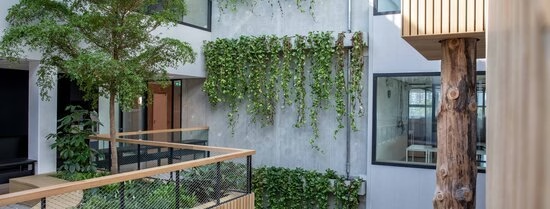Erasmus University Rotterdam (EUR) is investing in a sustainable campus. For the new Langeveld Building, the market was challenged to come up with innovative concepts. Main contractor BAM Bouw en Techniek, Paul de Ruiter Architects and Halmos consultants recommended the Earth, Wind & Fire (EWF) concept, which Benjamin Bronsema launched in 2013 in his doctoral research at TU Delft.
This concept provides a ventilation system without air conditioning, in which falling water, sun and wind provide fresh air. A bold choice by the EUR, as the system has not been used in an educational building before.

Powered by nature
The climate system is based on a natural ventilation concept. It works with a solar chimney which, in combination with a humidification system and venturi-cap, ensures that a natural flow of fresh air is generated. This system is very energy efficient and provides a healthy and comfortable indoor climate in the building. Research has shown that this system uses 20% less energy than traditional ventilation systems. Combined with all the other sustainable features of Langeveld Building, such as solar panels, this results in an Energy Performance Coefficient of less than zero. This means that the building can provide its own energy and even becomes energy-positive.
Because of the integral design approach, there are no additional costs involved in realizing the EWF installation concept. Moreover, because the system does not have large installations like traditional air handling units, there is more space left for teaching. This was an important benefit for Erasmus University Rotterdam.

The supply of clean air
Fresh air is drawn into the building through the wind catchers on the roof, located under the venturi caps. These wind catchers appear closed, but the wind can blow in through the grilles. Depending on the wind direction, sections can be closed with flaps, trapping the wind. If the wind comes from the northwest, the flaps on the east and south sides are closed and vice versa. If there is not enough wind, fans ensure that enough fresh air is still pushed into the shaft.
In that shaft - called the climate cascade - the system sprays the air with water. That cleans the air and creates downward pressure. At the bottom of the building, the air flows from the shaft through a heat exchanger that heats or cools the air via wells in the ground. Through an adjacent shaft, the clean air rises and flows into the rooms. Through grilles in the ceilings, the fresh air spreads through the rooms. After it has been used, the air is exhausted through the corridors and stairwells.

The exhaust of used air
In the south façade of the building there are two large solar chimneys. In these 8.5-meter-wide shafts, the sun warms the air, causing it to rise and create a negative pressure in the building. This creates a natural draft. At the top of the shafts is a kind of aircraft wing (the venturi cap), which acts like a funnel and accelerates the air blowing underneath. As a result, used air is drawn out of the building.

The building as a "climate machine
According to inventor Ben Bronsema, who received his doctorate on the EWF-concept in 2013, a building must be at least five stories high to benefit from Earth, Wind & Fire. The higher the building, the more energy is created by the falling air. The building must also be detached, as the sun and wind should have free play for the system to work properly.
With Ben’s idea for a building as a "climate machine," he wanted to improve the energy and cost efficiency of buildings and contribute to a better indoor climate. Pumping air around buildings in a traditional way causes bacteria to spread and air filters often turn out to be a source of contamination. Natural ventilation by architectural means is much healthier and works silently.
The EWF-lab foundation (www.ewflab.nl) offers more information about this revolutionary ventilation system. This foundation aims to accelerate innovations in natural climate control in buildings. The Earth, Wind & Fire concept for natural air conditioning serves as an inspiration in this regard, but it is not limiting.
